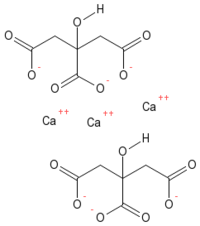- Calcium citrate
-
Calcium citrate  2-hydroxy-1,2,3-propane- tricarboxylic acid calcium salt (2:3)Other namesE333
2-hydroxy-1,2,3-propane- tricarboxylic acid calcium salt (2:3)Other namesE333Identifiers CAS number 813-94-5, 5785-44-4 (tetrahydrate) ChemSpider 12584 
EC number 212-391-7 Jmol-3D images Image 1 - [Ca+2].[Ca+2].[Ca+2].O=C([O-])CC(O)(C([O-])=O)CC(=O)[O-].[O-]C(=O)C(O)(CC([O-])=O)CC([O-])=O
Properties Molecular formula Ca3(C6H5O7)2 Molar mass 498.46 g/mol (anhydrous)
570.5 g/mol (tetrahydrate)Appearance White powder Density 1.63 g/cm3, solid Melting point 120 °C (loses water)
Boiling point Decomposes
Solubility in water 0.085 g/100 mL (18°C)
0.095 g/100 mL (25 °C)Hazards MSDS External MSDS Main hazards Irritant Related compounds Other cations Sodium citrate  citrate (verify) (what is:
citrate (verify) (what is:  /
/ ?)
?)
Except where noted otherwise, data are given for materials in their standard state (at 25 °C, 100 kPa)Infobox references Calcium citrate is the calcium salt of citric acid. It is commonly used as a food additive (E333), usually as a preservative, but sometimes for flavor. In this sense, it is similar to sodium citrate. Calcium citrate is also used as a water softener because the citrate ions can chelate unwanted metal ions. Calcium citrate is also found in some dietary calcium supplements (e.g. Citracal). Calcium makes up 21% of calcium citrate by weight.
Contents
Chemical properties
Calcium citrate is an odorless white powder, soluble in cold water.
Like citric acid, calcium citrate has a sour taste. Like other salts, however, it also has a salty taste. This should not be confused with the product commonly found in grocery stores labeled as "sour salt", which is simply powdered citric acid (which only resembles salt superficially).
Production
Calcium citrate is an intermediate in the isolation of citric acid from the fermentation process by which citric acid is produced industrially.[1] The citric acid in the broth solution is neutralized by calcium hydroxide, precipitating insoluble calcium citrate. This is then filtered off from the rest of the broth and washed to give clean calcium citrate.
The calcium citrate thus produced may be sold as-is, or it may be converted to citric acid using dilute sulfuric acid.
Biological role
In many individuals, bioavailability of calcium citrate is found to be equal to that of the cheaper calcium carbonate.[2] However, alterations to the digestive tract may change how calcium is digested and absorbed. According to recent research into calcium absorption after gastric bypass surgery,[3] calcium citrate may have improved bioavailability over calcium carbonate in Roux-en-Y gastric bypass patients who are taking calcium citrate as a dietary supplement after surgery. This is mainly due to the changes related to where calcium absorption occurs in the digestive tract of these individuals.
References
- ^ "Use of Lime in the Chemical Industry". National Lime Association. Archived from the original on 2006-09-29. http://web.archive.org/web/20060929115254/http://www.lime.org/ENV02/Other802.htm. Retrieved 2006-11-25.
- ^ Heaney RP, Dowell MS, Bierman J, Hale CA, Bendich A (June 2001). "Absorbability and cost effectiveness in calcium supplementation". Journal of the American College of Nutrition 20 (3): 239–46. PMID 11444420. http://www.jacn.org/cgi/content/full/20/3/239. Retrieved 2009-11-03.| PMID 11444420
- ^ Tondapu, P. and Provost, D. and Adams-Huet, B. and Sims, T. and Chang, C. and Sakhaee, K. (June 2009). "Comparison of the Absorption of Calcium Carbonate and Calcium Citrate after Roux-en-Y Gastric Bypass". Obesity Surgery 19 (9): 1256–1261. doi:10.1007/s11695-009-9850-6. PMID 19437082. http://www.springerlink.com/content/u85x563466x6771u/abstract. Retrieved 2010-08-11.
External links
Calcium compounds CaB6 · CaBr2 · CaC2 · CaCN2 · CaCO3 · CaC2O4 · CaCl · CaCl2 · Ca(ClO)2 · Ca(ClO3)2 · CaCrO4 · CaF2 · CaH2 · Ca(HCO3)2 · CaH2S2O6 · CaI2 · Ca(IO3)2 · Ca(MnO4)2 · Ca(NO3)2 · CaO · CaO2 · Ca(OH)2 · CaS · CaSO3 · CaSO4 · CaSi2 · CaTiO3 · Ca2P2O7 · Ca2SiO4 · Ca3(AsO4)2 · Ca3(BO3)2 · Ca3(C6H5O7)2 · Ca3N2 · Ca3P2 · Ca3(PO4)2 · Ca(H2PO4)2 · CaHPO4 · C36H70CaO4
Categories:- Citrates
- Calcium compounds
- Salts
Wikimedia Foundation. 2010.
